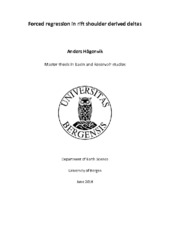| dc.contributor.author | Hågenvik, Anders | |
| dc.date.accessioned | 2018-08-16T15:30:53Z | |
| dc.date.available | 2018-08-16T15:30:53Z | |
| dc.date.issued | 2018-06-30 | |
| dc.date.submitted | 2018-06-29T22:00:10Z | |
| dc.identifier.uri | https://hdl.handle.net/1956/18131 | |
| dc.description.abstract | Footwall uplift and migration of fault activity have led to the preservation of spectacular down-stepping Gilbert-type deltas at the southern margin of the Corinth Rift. It is the purpose of this thesis to present the architecture and sedimentology of the down-stepping deltas to better understand the geological processes controlling this type of delta deposits. This study contributes with sedimentary and sequence stratigraphic analysis to better constrain the Late Pleistocene evolution of the southern margin of the Corinth Rift. Several studies have been conducted on the giant Gilbert-type deltas at the southern margin of the Corinth Rift; however there are no detailed studies on the Late Pleistocene deltas investigated in this study. Sedimentological and sequence stratigraphic data was obtained by combining traditional fieldwork techniques with digital acquisition techniques. Virtual outcrop models were generated from UAV data obtained during the field work and from an already existing LiDAR dataset. Six different delta bodies were mapped in the study area (Delta 1, Delta 2, Delta 3, Delta 4, Delta 5 and Delta 6). Eleven different facies were identified in the delta deposits, which are organized in four main facies associations: (1) topset, (2) foreset, (3) toeset and (4) bottomset. The sedimentology of the deltas is similar to previously studied giant Gilbert-type deltas at the southern margin of the Corinth Rif. The dimensions of the investigated deltas differ from the giant-Gilbert type deltas, which is interpreted to be due to their location on the footwall crest rather than in the immediate hangingwall. In general, the younger deltas are deposited topographically lower than the older deltas, except Delta 5 and Delta 6, which are deposited on top of Delta 4. Based on the analysis of shoreline trajectories and stratal termination surfaces recorded in the delta deposits, a significant relative sea-level rise from Delta 4 to Delta 6 is interpreted, which has not been described in previous work. | en_US |
| dc.language.iso | eng | eng |
| dc.publisher | The University of Bergen | en_US |
| dc.subject | Sequence stratigraphy | eng |
| dc.subject | shoreline trajectories | eng |
| dc.subject | Gilbert-type deltas | eng |
| dc.subject | Corinth Rift | eng |
| dc.subject | Pleistocene | eng |
| dc.subject | Facies analysis | eng |
| dc.subject | Pleistocen | nob |
| dc.subject | Riftsoner | nob |
| dc.subject | Sedimentologi | nob |
| dc.subject | Sekvensstratigrafi | nob |
| dc.title | Forced regression in rift shoulder derived deltas | en_US |
| dc.type | Master thesis | |
| dc.date.updated | 2018-06-29T22:00:10Z | |
| dc.rights.holder | Copyright the Author. All rights reserved | en_US |
| dc.description.degree | Masteroppgave i geovitenskap | en_US |
| dc.description.localcode | MAMN-GEOV | |
| dc.description.localcode | GEOV399 | |
| dc.subject.realfagstermer | https://data.ub.uio.no/realfagstermer/c000940 | |
| dc.subject.realfagstermer | https://data.ub.uio.no/realfagstermer/c008926 | |
| dc.subject.realfagstermer | https://data.ub.uio.no/realfagstermer/c011646 | |
| dc.subject.realfagstermer | https://data.ub.uio.no/realfagstermer/c012396 | |
| dc.subject.nus | 756199 | eng |
| fs.subjectcode | GEOV399 | |
| fs.unitcode | 12-50-0 | |
